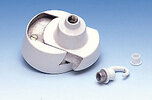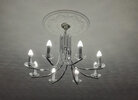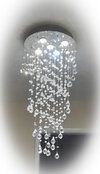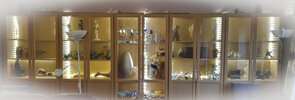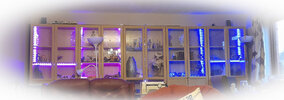With the switch back box used as a junction box one uses more cable, so not such a good loop impedance, and you lack a permanent line at the lights for emergency lights and fans etc. But it also allows the home to be wired side to side easier, so there is a more even draw on each circuit.
As to neutral at the switch using triple and earth drops instead of twin and earth one can select to use third wire as either neutral or for two way switching in the future.
The ceiling rose is designed to run the supply rose to rose, but when we use lamps designed for other countries often these don't have the terminals required, I used a plug in ceiling rose, so changing a chandelier is wired on the ground,
View attachment 336370 then simply plugged in. No holding a lamp up in the air while wiring it, so I never have reason to open the base of ceiling rose. As to electronic switches, the dimmer switch can't adjust colour any more, dimming a tungsten bulb also produced a red glow, not so with LED, so using smart bulbs works better allowing the colour to also be changed so giving a better ambiance. Using however a 8 bulb chandelier this gets expensive,
View attachment 336373 but the whole reason for it is to get the light required in a large room, so don't really want to dim, so use a simple on/off smart switch battery powered so does not need a neutral (TP-Link/Tapo) in other rooms I have used Energenie/MiHome switches which pass a small current through the bulb when off, have had a shimmer and bulb glowing when switched off, and of 5 fitted 3 have failed in 8 years, so have been moving over, but the new switches only a year old, so time will tell.
The problem with many smart switches is they use a single line in even with two or more line outs, this can cause problems where different switches on the plate have different supplies, I have one 4 gang switch with three supplies, two at 230 volt and one extra low voltage, so can't be grouped together.
Smart switching can be three main locations, in the bulb, in the lamp (smart relay) and in the switch, I have all three, this lamp
View attachment 336377used a smart relay inside the lamp so I can select either centre or outer bulbs, the centre one is colour changing smart bulb, at rewire stage there is nothing stopping one from having multi-lamps in a room independently switched seen it first in Turkey, where they use CFL well before us, tungsten produces too much heat, and you could not dim CFL bulbs, so they split the lights 1/3 and 2/3 so one has three levels of lighting, be it wall lights or ceiling lights, one can arrange the lights so it does not look as if bulbs have blown, I have had to work with what I have, no where near rewire stage, so used cabinet lights to supplement living room lighting. When turned up full
View attachment 336378 there is around 60 watt of lighting there, but normally turned down
View attachment 336379 and set to some colour to enhance the display.
I am trying to give ideas in action, there is no right or wrong, the electronic lighting has turned the whole lighting systems upside down, we used a push button to turn lights on/off in dinning room converted into sick bedroom, so lights could be turned on/off in the bed, but found voice control with google Nest Mini speakers worked better, so button is now a door bell push.
We wanted all lights controller at the door, so on leaving room we can turn them all off together, however again voice command control has removed that problem, we simple say hey google turn off living room lights. And at 72 I have been know to dose off watching day time TV which has timed out, meaning I wake up in total darkness, with cat toys everywhere, hey google turn on lights is a live saver, I would have not dreamed of this 5 years ago.


